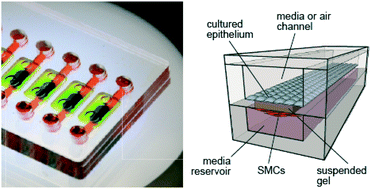Our official English website, www.x-mol.net, welcomes your feedback! (Note: you will need to create a separate account there.)
Microfluidic lung airway-on-a-chip with arrayable suspended gels for studying epithelial and smooth muscle cell interactions
Lab on a Chip ( IF 6.1 ) Pub Date : 2018-04-05 00:00:00 , DOI: 10.1039/c7lc01357d Mouhita Humayun 1, 2, 3, 4, 5 , Chung-Wai Chow 3, 4, 6, 7, 8 , Edmond W. K. Young 1, 2, 3, 4, 5
Lab on a Chip ( IF 6.1 ) Pub Date : 2018-04-05 00:00:00 , DOI: 10.1039/c7lc01357d Mouhita Humayun 1, 2, 3, 4, 5 , Chung-Wai Chow 3, 4, 6, 7, 8 , Edmond W. K. Young 1, 2, 3, 4, 5
Affiliation

|
Chronic lung diseases (CLDs) are regulated by complex interactions between many different cell types residing in lung airway tissues. Specifically, interactions between airway epithelial cells (ECs) and airway smooth muscle cells (SMCs) have been shown in part to play major roles in the pathogenesis of CLDs, but the underlying molecular mechanisms are not well understood. To advance our understanding of lung pathophysiology and accelerate drug development processes, new innovative in vitro tissue models are needed that can reconstitute the complex in vivo microenvironment of human lung tissues. Organ-on-a-chip technologies have recently made significant strides in recapitulating physiological properties of in vivo lung tissue microenvironments. However, novel advancements are still needed to enable the study of airway SMC–EC communication with matrix interactions, and to provide higher throughput capabilities and manufacturability. We have developed a thermoplastic-based microfluidic lung airway-on-a-chip model that mimics the lung airway tissue microenvironment, and in particular, the interactions between SMCs, ECs, and supporting extracellular matrix (ECM). The microdevice is fabricated from acrylic using micromilling and solvent bonding techniques, and consists of three vertically stacked microfluidic compartments with a bottom media reservoir for SMC culture, a middle thin hydrogel layer, and an upper microchamber for achieving air–liquid interface (ALI) culture of the epithelium. A unique aspect of the design lies in the suspended hydrogel with upper and lower interfaces for EC and SMC culture, respectively. A mixture of type I collagen and Matrigel was found to promote EC adhesion and monolayer formation, and SMC adhesion and alignment. Optimal culturing protocols were established that enabled EC–SMC coculture for more than 31 days. Epithelial monolayers displayed common morphological markers including ZO-1 tight junctions and F-actin cell cortices, while SMCs exhibited enhanced cell alignment and expression of α-SMA. The thermoplastic device construction facilitates mass manufacturing, allows EC–SMC coculture systems to be arrayed for increased throughput, and can be disassembled to allow extraction of the suspended gel for downstream analyses. This airway-on-a-chip device has potential to significantly advance our understanding of SMC–EC–matrix interactions, and their roles in the development of CLDs.
中文翻译:

微流控肺气道芯片,带有可排列的悬浮凝胶,用于研究上皮和平滑肌细胞之间的相互作用
慢性肺部疾病(CLD)通过驻留在肺气道组织中的许多不同细胞类型之间的复杂相互作用来调节。具体而言,已显示气道上皮细胞(ECs)和气道平滑肌细胞(SMCs)之间的相互作用部分在CLD的发病机理中起主要作用,但尚未充分理解其潜在的分子机制。为了增进我们对肺部病理生理学的了解并加快药物开发过程,需要新的创新性体外组织模型来重构人肺组织的复杂体内微环境。芯片上器官技术最近在概括体内生理特性方面取得了重大进展肺组织微环境。但是,仍需要进行新颖的改进,以便能够研究具有基质相互作用的气道SMC-EC通讯,并提供更高的吞吐能力和可制造性。我们已经开发了一种基于热塑性塑料的微流控肺上芯片模型,该模型可以模拟肺气道组织的微环境,尤其是SMC,EC和支持细胞外基质(ECM)之间的相互作用。该微设备由丙烯酸使用微铣削和溶剂粘合技术制成,由三个垂直堆叠的微流体隔室组成,该微流体隔室具有用于SMC培养的底部培养基容器,中间的薄水凝胶层和用于实现气液界面(ALI)培养的上部微腔室上皮细胞。设计的独特之处在于悬浮的水凝胶,分别具有用于EC和SMC培养的上下界面。发现I型胶原蛋白和Matrigel的混合物可促进EC粘附和单层形成,以及SMC粘附和排列。建立了使EC–SMC共培养超过31天的最佳培养方案。上皮单层显示常见的形态学标志物,包括ZO-1紧密连接和F-肌动蛋白细胞皮层,而SMC表现出增强的细胞排列和α-SMA的表达。热塑性装置的构造有利于批量生产,可以排列EC–SMC共培养系统以提高通量,并且可以拆卸以提取悬浮凝胶以用于下游分析。
更新日期:2018-04-05
中文翻译:

微流控肺气道芯片,带有可排列的悬浮凝胶,用于研究上皮和平滑肌细胞之间的相互作用
慢性肺部疾病(CLD)通过驻留在肺气道组织中的许多不同细胞类型之间的复杂相互作用来调节。具体而言,已显示气道上皮细胞(ECs)和气道平滑肌细胞(SMCs)之间的相互作用部分在CLD的发病机理中起主要作用,但尚未充分理解其潜在的分子机制。为了增进我们对肺部病理生理学的了解并加快药物开发过程,需要新的创新性体外组织模型来重构人肺组织的复杂体内微环境。芯片上器官技术最近在概括体内生理特性方面取得了重大进展肺组织微环境。但是,仍需要进行新颖的改进,以便能够研究具有基质相互作用的气道SMC-EC通讯,并提供更高的吞吐能力和可制造性。我们已经开发了一种基于热塑性塑料的微流控肺上芯片模型,该模型可以模拟肺气道组织的微环境,尤其是SMC,EC和支持细胞外基质(ECM)之间的相互作用。该微设备由丙烯酸使用微铣削和溶剂粘合技术制成,由三个垂直堆叠的微流体隔室组成,该微流体隔室具有用于SMC培养的底部培养基容器,中间的薄水凝胶层和用于实现气液界面(ALI)培养的上部微腔室上皮细胞。设计的独特之处在于悬浮的水凝胶,分别具有用于EC和SMC培养的上下界面。发现I型胶原蛋白和Matrigel的混合物可促进EC粘附和单层形成,以及SMC粘附和排列。建立了使EC–SMC共培养超过31天的最佳培养方案。上皮单层显示常见的形态学标志物,包括ZO-1紧密连接和F-肌动蛋白细胞皮层,而SMC表现出增强的细胞排列和α-SMA的表达。热塑性装置的构造有利于批量生产,可以排列EC–SMC共培养系统以提高通量,并且可以拆卸以提取悬浮凝胶以用于下游分析。



























 京公网安备 11010802027423号
京公网安备 11010802027423号